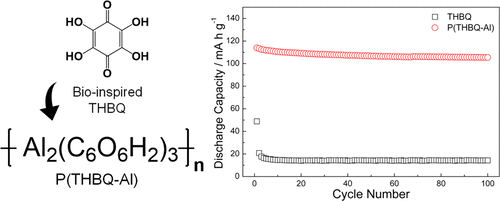当前位置:
X-MOL 学术
›
ACS Appl. Mater. Interfaces
›
论文详情
Our official English website, www.x-mol.net, welcomes your feedback! (Note: you will need to create a separate account there.)
Environmentally Sustainable Aluminum-Coordinated Poly(tetrahydroxybenzoquinone) as a Promising Cathode for Sodium Ion Batteries
ACS Applied Materials & Interfaces ( IF 9.5 ) Pub Date : 2018-01-16 00:00:00 , DOI: 10.1021/acsami.7b13911 Hee Joong Kim 1 , Youngjin Kim 1 , Jimin Shim 1 , Kyung Hwa Jung 1 , Min Soo Jung 1 , Hanseul Kim 1 , Jong-Chan Lee 1 , Kyu Tae Lee 1
ACS Applied Materials & Interfaces ( IF 9.5 ) Pub Date : 2018-01-16 00:00:00 , DOI: 10.1021/acsami.7b13911 Hee Joong Kim 1 , Youngjin Kim 1 , Jimin Shim 1 , Kyung Hwa Jung 1 , Min Soo Jung 1 , Hanseul Kim 1 , Jong-Chan Lee 1 , Kyu Tae Lee 1
Affiliation

|
Na-ion batteries are attractive as an alternative to Li-ion batteries because of their lower cost. Organic compounds have been considered as promising electrode materials due to their environmental friendliness and molecular diversity. Herein, aluminum-coordinated poly(tetrahydroxybenzoquinone) (P(THBQ-Al)), one of the coordination polymers, is introduced for the first time as a promising cathode for Na-ion batteries. P(THBQ-Al) is synthesized through a facile coordination reaction between benzoquinonedihydroxydiolate (C6O6H22–) and Al3+ as ligands and complex metal ions, respectively. Tetrahydroxybenzoquinone is environmentally sustainable, because it can be obtained from natural resources such as orange peels. Benzoquinonedihydroxydiolate also contributes to delivering high reversible capacity, because each benzoquinonedihydroxydiolate unit is capable of two electron reactions through the sodiation of its conjugated carbonyl groups. Electrochemically inactive Al3+ improves the structural stability of P(THBQ-Al) during cycling because of a lack of a change in its oxidation state. Moreover, P(THBQ-Al) is thermally stable and insoluble in nonaqueous electrolytes. These result in excellent electrochemical performance including a high reversible capacity of 113 mA h g–1 and stable cycle performance with negligible capacity fading over 100 cycles. Moreover, the reaction mechanism of P(THBQ-Al) is clarified through ex situ XPS and IR analyses, in which the reversible sodiation of C═O into C–O–Na is observed.
中文翻译:

环境可持续的铝配位的聚(四羟基苯醌)作为钠离子电池的有希望的阴极
Na-离子电池由于其较低的成本而作为锂离子电池的替代品具有吸引力。由于有机化合物的环境友好性和分子多样性,它们被认为是很有前途的电极材料。在此,作为配位聚合物之一的铝配位的聚(四羟基苯醌)(P(THBQ-Al))首次被引入作为有希望的钠离子电池阴极。P(THBQ-Al)是通过苯醌二羟基二醇酸酯(C 6 O 6 H 2 2-)与Al 3+之间的易配位反应合成的分别作为配体和复杂的金属离子。四羟基苯醌是环境可持续的,因为它可以从自然资源(例如橙皮)中获得。苯醌二羟基二醇酯还有助于传递高可逆容量,因为每个苯醌二羟基二醇酯单元都可以通过其共轭羰基的磺化反应进行两个电子反应。电化学上无活性的Al 3+由于缺乏氧化态的变化,因此改善了循环过程中P(THBQ-Al)的结构稳定性。此外,P(THBQ-Al)具有热稳定性,不溶于非水电解质。这导致出色的电化学性能,包括113 mA hg –1的高可逆容量稳定的循环性能,超过100个循环的容量可忽略不计。此外,通过异位XPS和IR分析阐明了P(THBQ-Al)的反应机理,其中观察到了C═O可逆地向C-O-Na的磺化。
更新日期:2018-01-16
中文翻译:

环境可持续的铝配位的聚(四羟基苯醌)作为钠离子电池的有希望的阴极
Na-离子电池由于其较低的成本而作为锂离子电池的替代品具有吸引力。由于有机化合物的环境友好性和分子多样性,它们被认为是很有前途的电极材料。在此,作为配位聚合物之一的铝配位的聚(四羟基苯醌)(P(THBQ-Al))首次被引入作为有希望的钠离子电池阴极。P(THBQ-Al)是通过苯醌二羟基二醇酸酯(C 6 O 6 H 2 2-)与Al 3+之间的易配位反应合成的分别作为配体和复杂的金属离子。四羟基苯醌是环境可持续的,因为它可以从自然资源(例如橙皮)中获得。苯醌二羟基二醇酯还有助于传递高可逆容量,因为每个苯醌二羟基二醇酯单元都可以通过其共轭羰基的磺化反应进行两个电子反应。电化学上无活性的Al 3+由于缺乏氧化态的变化,因此改善了循环过程中P(THBQ-Al)的结构稳定性。此外,P(THBQ-Al)具有热稳定性,不溶于非水电解质。这导致出色的电化学性能,包括113 mA hg –1的高可逆容量稳定的循环性能,超过100个循环的容量可忽略不计。此外,通过异位XPS和IR分析阐明了P(THBQ-Al)的反应机理,其中观察到了C═O可逆地向C-O-Na的磺化。


























 京公网安备 11010802027423号
京公网安备 11010802027423号